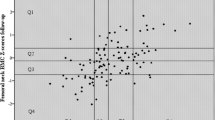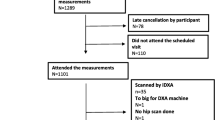Abstract
Fragility fractures are correlated to reduced bone size and/or reduced volumetric bone density (vBMD). These region-specific deficits may originate from reduced mineral accrual and/or reduced skeletal growth during the first 2 decades of life. Before pathological development can be defined, normal skeletal growth must be described. To evaluate growth of bone size, accrual of bone mineral content (BMC), areal bone mineral density (aBMD) and vBMD in a population-based cohort, 44 boys and 42 girls were followed by annual measurements from the age of 12 to 16 (attendance rates 90–100%). Segmental bone length, bone width, BMC, aBMD and vBMD were measured by dual-energy X-ray absorptiometry (DXA). Data were compared with predicted adult peak, as determined in 36 men aged 27.7±4.6 years and 44 women aged 26.8±4.9 years. Growth in width of the femoral neck precedes accrual of BMC in the femoral neck in both genders up to age 15. The girls were at all ages closer to their predicted adult peak in both bone width and BMC compared with the boys except in the femoral neck. As femoral neck vBMD had reached its predicted adult peak already at 12 years in both genders, the increase in femoral neck BMC and femoral neck aBMD from age 12 to 16 was most likely to be explained by the increase in bone size. In boys the peak velocity growth was recorded at ~14 years for BMC, height, width and lean mass. Growth from the age of 12 to 16 seems to build a bigger but not a denser skeleton in the femoral neck.





Similar content being viewed by others
References
Karlsson M, Duan Y, Ahlborg H, Obrant K, Johnell O, Seeman E (2001) Age, gender, and fragility fractures are associated with differences in quantitative ultrasound independent of bone mineral density. Bone 28:118–122
Seeman E, Duan Y, Fong C, Edmonds J (2001) Fracture site-specific deficits in bone size and volumetric density in men with spine or hip fractures. J Bone Miner Res 16:120–127
Duan Y, Parfitt A, Seeman E (1999) Vertebral bone mass, size, and volumetric density in women with spinal fractures. J Bone Miner Res 14:1796–1802
Evans RA, Marel GM, Lancaster EK, Kos S, Evans M, Wong SY (1988) Bone mass is low in relatives of osteoporotic patients. Ann Int Med 109:870–873
Seeman E, Hopper JL, Bach LA et al. (1989) Reduced bone mass in daughters of women with osteoporosis. N Engl J Med 320:554–558
Ristevski S, Yeung S, Poon C, Wark JW, Ebeling P (1997) Ostepenia is common in young first-degree realtives of men with osteoporosis. Annual scientific meeting of Australian and New Zealand Bone Min Soc, Canberra, Australia
Seeman E, Karlsson MK, Duan Y (2000) On exposure to anorexia nervosa, the temporal variation in axial and appendicular skeletal development predisposes to site-specific deficits in bone size and density: a cross-sectional study. J Bone Miner Res 15:2259–2265
Bonjour JP, Theintz G, Buchs B, Slosman D, Rizzoli R (1991) Critical years and stages of puberty for spinal and femoral bone mass accumulation during adolescence. J Clin Endocrinol Metab 73:555–563
Lloyd T, Rollings N, Andon MB et al. (1992) Determinants of bone density in young women. I. Relationships among pubertal development, total body bone mass, and total body bone density in premenarchal females. J Clin Endocrinol Metab 75:383–387
Bailey DA, McKay HA, Mirwald RL, Crocker PR, Faulkner RA (1999) A six-year longitudinal study of the relationship of physical activity to bone mineral accrual in growing children: the University of Saskatchewan bone mineral accrual study. J Bone Miner Res 14:1672–1679
Karlsson MK, Obrant KJ, Nilsson BE, Johnell O (2000) Changes in bone mineral, lean body mass and fat content as measured by dual energy X-ray absorptiometry: a longitudinal study. Calcif Tissue Int 66:97–99
Bailey DA (1997) The Saskatchewan Pediatric Bone Mineral Accrual Study: bone mineral acquisition during the growing years. Int J Sports Med 18:S191–194
Maynard LM, Guo SS, Chumlea WC et al. (1998) Total-body and regional bone mineral content and areal bone mineral density in children aged 8–18 y: the Fels Longitudinal Study. Am J Clin Nutr 68:1111–1117
Bachrach LK, Hastie T, Wang MC, Narasimhan B, Marcus R (1999) Bone mineral acquisition in healthy Asian, Hispanic, black, and Caucasian youth: a longitudinal study. J Clin Endocrinol Metab 84:4702–4712
Nguyen TV, Maynard LM, Towne B et al. (2001) Sex differences in bone mass acquisition during growth: the Fels Longitudinal Study. J Clin Densitom 4:147–157
Sundberg M, Gardsell P, Johnell O et al. (2001) Peripubertal moderate exercise increases bone mass in boys but not in girls: a population-based intervention study. Osteoporos Int 12:230–238
Sundberg M, Gardsell P, Johnell O et al. (2002) Physical activity increases bone size in prepubertal boys and bone mass in prepubertal girls: a combined cross-sectional and 3-year longitudinal study. Calcif Tissue Int 71:406–415
Karlsson MK, Obrant KJ, Nilsson BE, Johnell O (1998) Bone mineral density assessed by quantitative ultrasound and dual energy X-ray absorptiometry. Normative data in Malmo, Sweden. Acta Orthop Scand 69:189–193
Cowell CT, Lu PW, Lloyd-Jones SA et al. (1995) Volumetric bone mineral density—a potential role in paediatrics. Acta Paediatr Suppl 411:12–6, 17
Lu PW, Cowell CT, LLoyd-Jones SA, Briody JN, Howman-Giles R (1996) Volumetric bone mineral density in normal subjects, aged 5–27 years. J Clin Endocrinol Metab 81:1586–1590
Duke PM, Litt IF, Gross RT (1980) Adolescents' self-assessment of sexual maturation. Pediatrics 66:918–920
Bass S, Delmas PD, Pearce G, Hendrich E, Tabensky A, Seeman E (1999) The differing tempo of growth in bone size, mass, and density in girls is region-specific. J Clin Invest 104:795–804
Bradney M, Karlsson MK, Duan Y, Stuckey S, Bass S, Seeman E (2000) Heterogeneity in the growth of the axial and appendicular skeleton in boys: implications for the pathogenesis of bone fragility in men. J Bone Miner Res 15:1871–1878
Fournier PE, Rizzoli R, Slosman DO, Theintz G, Bonjour JP (1997) Asynchrony between the rates of standing height gain and bone mass accumulation during puberty. Osteoporos Int 7:525–532
Bradney M, Pearce G, Naughton G et al. (1998) Moderate exercise during growth in prepubertal boys: changes in bone mass, size, volumetric density, and bone strength: a controlled prospective study. J Bone Miner Res 13:1814–1821
Theintz G, Buchs B, Rizzoli R et al. (1992) Longitudinal monitoring of bone mass accumulation in healthy adolescents: evidence for a marked reduction after 16 years of age at the levels of lumbar spine and femoral neck in female subjects. J Clin Endocrinol Metab 75:1060–1065
Matkovic V, Jelic T, Wardlaw GM et al. (1994) Timing of peak bone mass in Caucasian females and its implication for the prevention of osteoporosis. Inference from a cross-sectional model. J Clin Invest 93:799–808
Garn SM (1970) The earlier gain and later loss of cortical bone. Nutritional perspectives. C.C. Thomas Publishers, Springfield, Illinois, pp 3−120
Bass SL, Saxon L, Daly RM et al. (2002) The effect of mechanical loading on the size and shape of bone in pre-, peri-, and postpubertal girls: a study in tennis players. J Bone Miner Res 17:2274–2280
Ruff CB, Hayes WC (1988) Sex differences in age-related remodeling of the femur and tibia. J Orthop Res 6:886–896
Gärdsell P, Johnell O, Nilsson BE (1989) Predicting fractures in women by using forearm bone densitometry. Calcif Tissue Int 44:235–242
Hui SL, Slemenda CW, Johnston Jr CC (1989) Baseline measurement of bone mass predicts fracture in white women. Ann Int Med 111:355–361
Melton LJ 3, Atkinson EJ, O'Fallon WM, Wahner HW, Riggs BL (1993) Long-term fracture prediction by bone mineral assessed at different skeletal sites. J Bone Miner Res 8:1227–1233
Düppe H, Gärdsell P, Nilsson B, Johnell O (1997) A single bone density measurement can predict fractures over 25 years. Calcif Tissue Int 60:171–174
Düppe H (1997) Bone mass in young adults. Determinants and fracture prediction. Thesis, Malmö, Lund University
Sundberg M, Gärdsell P, Johnell O, Ornstein E, Sernbo I (1998) Comparison of quantitative ultrasound measurements in calcaneus with DXA and SXA at other skeletal sites: a population-based study on 280 children aged 11–16 years. Osteoporos Int 8:410–417
Bass S, Pearce G, Bradney M et al. (1998) Exercise before puberty may confer residual benefits in bone density in adulthood: studies in active prepubertal and retired female gymnasts. J Bone Miner Res 13:500–507
Gilsanz V, Boechat MI, Roe TF, Loro ML, Sayre JW, Goodman WG (1994) Gender differences in vertebral body sizes in children and adolescents. Radiology 190:673–677
Acknowledgements
Financial support was obtained from Kristianstad Higher Educational School, Region Skåne, Lund University and Malmö University Hospital Foundations.
Author information
Authors and Affiliations
Corresponding author
Rights and permissions
About this article
Cite this article
Sundberg, M., Gärdsell, P., Johnell, O. et al. Pubertal bone growth in the femoral neck is predominantly characterized by increased bone size and not by increased bone density—a 4-year longitudinal study. Osteoporos Int 14, 548–558 (2003). https://doi.org/10.1007/s00198-003-1406-3
Received:
Accepted:
Published:
Issue Date:
DOI: https://doi.org/10.1007/s00198-003-1406-3




